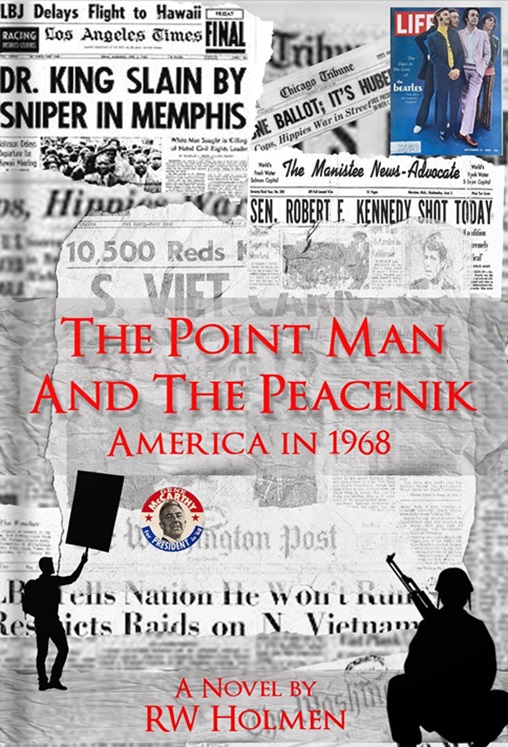The United States nearly ripped apart at the seams in 1968, the most tumultuous year of Twentieth Century America. History herself seemed confused as she zigged and zagged and changed course several times.
Choices. It’s all about choices. The Vietnam War, and one’s reaction to it, defined the generation that came of age in the turbulent ‘60s. From the novel’s opening paragraph, the moral ambiguity of this war confronts a “fucking new guy” in the mountainous jungles of central Vietnam. Does he shoot and ask questions later? Meanwhile, his high school buddy is bloodied by a policeman’s baton as he protests the war.
The novel will transport the reader to the tempestuous year of 1968. By depicting actual events in an artful manner, the novel shares aspects of narrative nonfiction. Creative and entertaining re-creation of historical events serves as an entryway into racial, class, cultural, political, and military history. The novel re-creates historical persons and events from an eyewitness perspective with the hope that the reader feels the moment as a lived experience. The events of 1968 are revisited, not as stale historical remnants, but as presaging the issues of today.
The novel features a pair of protagonists, high school classmates from a small midwestern town, who follow different paths. One is off to Vietnam as a combat infantryman, and the other joins the anti-war movement. To add spice to the stew, they are in love with the same woman. Each faces hard choices as they come of age: sex and relationships, drugs, hopes and disillusionment, and the dilemma of compulsory military service in a war of dubious purpose and questionable strategy and tactics. Race and bigotry challenge them, as do class and privilege.
From New Year’s Eve 1967 to the conclusion on New Year’s Eve 1968, the novel follows a chronological pattern of alternating chapters between the two main characters. Along the way, the characters weave in and out of the major events of the year and interact with actual, historical figures: the Tet Offensive, Eugene McCarthy’s shock-the-world candidacy in New Hampshire, the siege of Khe Sanh, young John Lewis recounting the early civil rights movement, urban riots following the assassination of Martin Luther King, Jr., Robert F. Kennedy’s assassination in Los Angeles just as it appeared he might be the next president, the rise of hippie counter-culture, the riotous Democratic National Convention in Chicago, and segregationist George Wallace spouting grievances and mesmerizing a raucous crowd at Madison Square Garden.
To the readers from the generation now enjoying Social Security, remember the times, the tunes, and the tribulations. To the Vietnam vet, a belated, “Welcome home!” To younger folk, perhaps you will say, “Ok Boomer, I understand you a bit better.”
Purchase your copy direct from the author for $19.95 plus shipping and handling.
